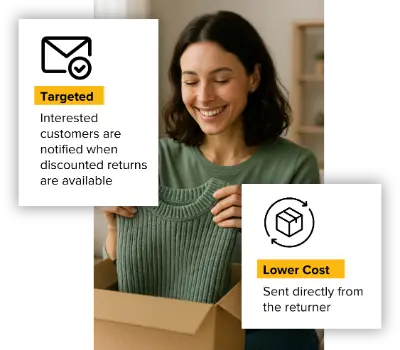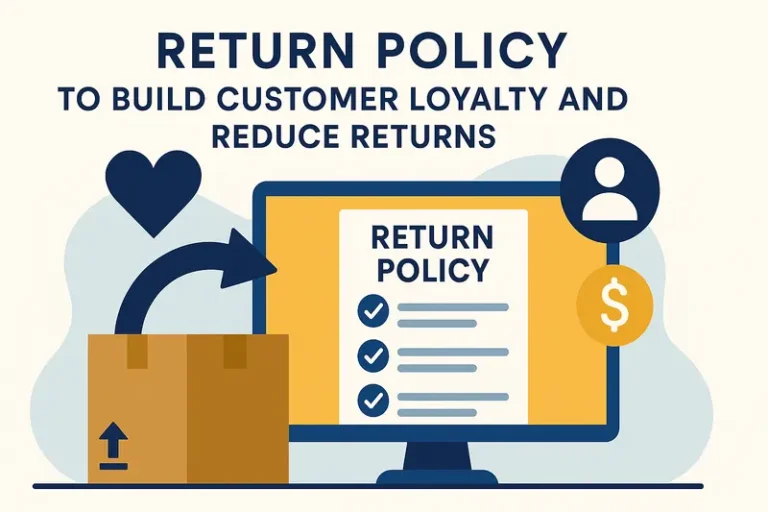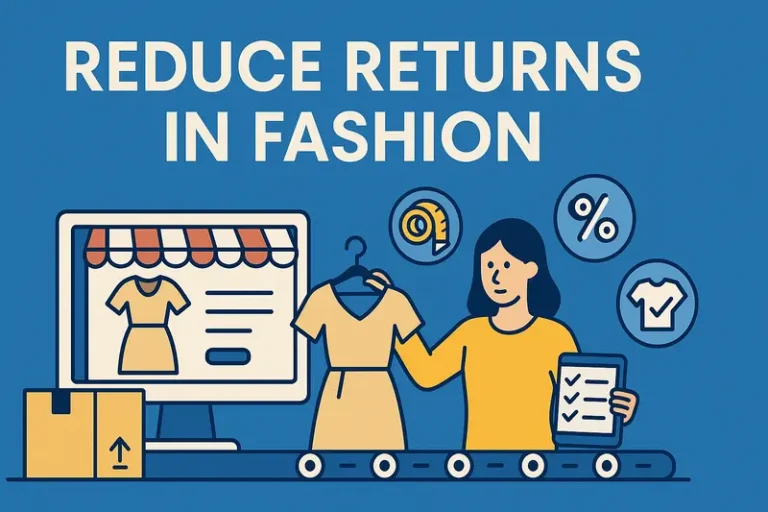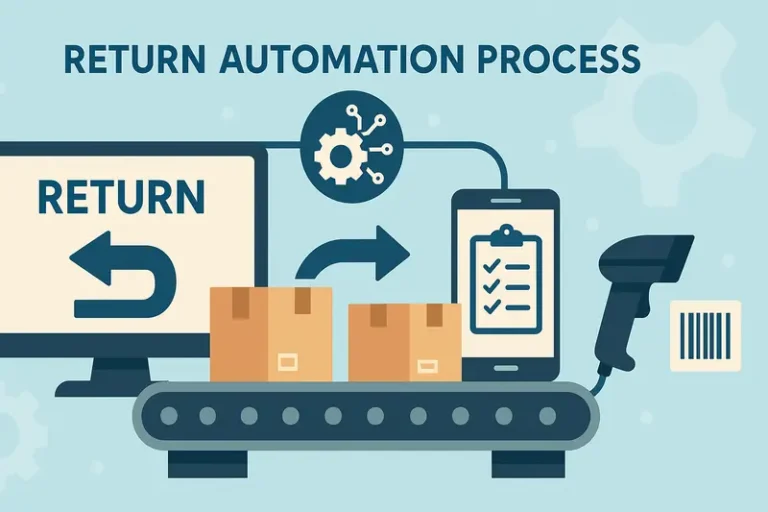Crafting the Perfect Ecommerce Returns Program | Cahoot

Last updated on February 28, 2025

In this article
 15 minutes
15 minutes
Ecommerce returns are an unavoidable aspect of online retail, and return rates have been steadily rising (averaging 20-30% across the industry, compared to under 10% in brick-and-mortar stores). This results in a critical challenge for retailers and a complex consumer experience. What was once a simple transaction has transformed into a nuanced ecosystem of choice. As consumers become comfortable moving more and more of their purchases online to take advantage of the nearly infinite product selection, they likewise become comfortable returning those purchases.
Understanding the Impact of Returns on Online Sellers
The reasons behind returns are as diverse as the products being shipped back. Some returns stem from practical issues like incorrect apparel sizing, inaccurate product descriptions, or items that don’t match online imagery. Others are driven by more strategic consumer behaviors like “bracketing,” where shoppers intentionally order multiple variations of a product, planning to keep only one, or “wardrobing,” where items are worn and then returned (a form of returns fraud). These practices exacerbate returns rates, posing significant challenges for online retailers in terms of inventory management, customer service, and logistics.
Regardless of the reason for the ludicrous $500+ billion value of goods returned in the US in 2024, the cost of supporting them is increasing with no relief in sight. The cost of labor is rising every year. The costs from transportation, real estate and facility operations, returns processing, and loss of sellable inventory… go up yearly. But while ecommerce retailers and brands can’t afford to alienate customers and disincentivize returns, they likewise can’t ignore the increasing margin erosion. An exceptional returns process builds trust, improves customer satisfaction, and encourages repeat purchases. Numerous studies have found that ~92% of consumers will buy from a retailer again if the return process is easy.
Brands must balance the costs of supporting returns with the benefits of customer loyalty. Consumers want to know their options before buying to ensure a hassle-free experience. Sellers wish to encourage conversion because acquiring a customer can cost five times more than retaining one. Offering free or hassle-free returns can make a business more appealing but also comes with challenges, especially for smaller merchants. Some Sellers use innovative strategies like peer-to-peer return solutions, localized drop-off points, or charging restocking fees to manage costs. Some leverage help from third-party logistics (3PL) partners to outsource returns management to minimize operational overhead such as inspection, relisting, processing, and issuing refunds. The item can then be stored at the 3PL to fulfill a new order.
The most cost-effective reverse logistics strategy involves leveraging a centralized returns center with a dedicated location to handle returns and specially trained (highly efficient) staff. It also involves automating processes wherever possible, utilizing return-ready packaging that can be easily resealed and reused to eliminate repackaging costs, and analyzing return data to identify trends and proactively address common return reasons. Streamlining the returns process through technology and efficient management minimizes labor costs and optimizes inventory handling and tracking.
However, most of the costs associated with returned orders lay in the transportation. Sellers can certainly negotiate better shipping rates, but there’s a limit to what discounts can be achieved, and Sellers that fully outsource their fulfillment to 3PLs don’t even have control over that piece of the puzzle. So, how can you introduce a competitive ecommerce returns program that accommodates all different types of returns? Let’s take a look:
Make Returns Profitable, Yes!
Cut shipping and processing costs by 70% with our patented peer-to-peer returns solution. 4x faster than traditional returns.
See How It WorksStrategies to Minimize Returns
The first step in implementing an exceptional returns program to encourage customer loyalty is to spend the time to avoid returns in the first place. Businesses should focus on the many aspects of the customer experience that lead to returns. Additionally, companies should invest in packaging and void fill sufficient to prevent damage in transit. Lastly, merchants can identify and address the root causes of returns by carefully monitoring return trends beyond these suggestions.
To minimize returns, online retailers can focus on providing clear and detailed product information. This includes providing accurate product information using high-quality images and comprehensive descriptions, implementing robust sizing guides, and encouraging customer reviews to help potential buyers. When customers have all the information they need to make informed purchasing decisions, they are less likely to return items. For example, in the apparel industry, providing detailed measurements and fit guides can help customers choose the right size, reducing the likelihood of returns due to sizing issues.
Additionally, offering virtual try-on tools, such as augmented reality (AR) and 3D models, can allow customers to see how a product fits and looks without having to physically try it on. These tools provide a more accurate representation of the product, helping to reduce the number of returns and improve customer satisfaction. By investing in these technologies, online retailers can enhance the online shopping experience and build customer loyalty.
Leveraging Technology to Improve Returns
Technology can play a significant role in improving the returns process for online retailers. Returns management systems can help track and manage returns, making it easier to identify areas for improvement. These systems can automate many aspects of the returns process, reducing the time and effort required to handle returns.
Additionally, data analytics can provide insights into return trends and patterns, allowing online retailers to make data-driven decisions to minimize returns. By analyzing return data, retailers can identify common reasons for returns and take proactive steps to address them. For example, if a particular product has a high return rate due to sizing issues, the retailer can update the product descriptions and sizing charts to provide more accurate information.
Returns via Small Parcel Shipping
Ecommerce returns by small parcel shipping (USPS, UPS, FedEx, etc.) offer convenience for customers by allowing them to simply repackage their order, print and affix a pre-paid shipping label, and then either schedule free carrier pickup (in most cases) or dropoff to a convenient carrier location or network store such as a UPS Store, FedEx Office, or the like. But this type of return comes with major drawbacks, including very high shipping costs, the potential for the package to be lost or damaged in return transit, shipping delays that prevent the inventory from being resold and fulfilled promptly, lengthier time to refund/credit which is beyond the customer’s expectations because item inspection naturally takes longer.
Customers may be happier with parcel shipping directly to the returns processing facility (maybe they’re in a more rural setting, and it’s more convenient to choose their preferred carrier). Still, the extra shipping is terrible for the planet. Merchants will likely use lower-cost shipping available, which could potentially lead to additional delays. Merchants could receive hundreds or thousands of small parcel deliveries at a time that must be opened, inspected, perhaps rebarcoded with the accurate SKU for the condition, put away, inventory tracked, item relisted for sale, and the cycle begins again.
Another huge disadvantage is the removal of checks and balances against returns fraud. Trusting Sellers (or those looking to build trust with their customers by quickly refunding) may receive the wrong item back, no item at all, or a box of rocks (true story). Returns fraud and abuse substantially increase the overall cost of returns.
Convert Returns Into New Sales and Profits
Our peer-to-peer returns system instantly resells returned items—no warehouse processing, and get paid before you refund.
I'm Interested in Peer-to-Peer ReturnsBoxless Returns
Boxless returns have several advantages. Firstly, transportation is the largest cost in ecommerce reverse logistics (assuming high-value items were not damaged in transit and returns fraud and abuse are not a factor). Giving the customer the option to bring the items to a local returns desk (aka attended kiosk) allows for consolidating returns into larger shipments sent to a regional facility in groups, reducing transportation costs considerably. They can then be sorted en masse and further consolidated so that full truckloads containing tens of thousands of units from nationwide kiosks are delivered to the returns facilities at once and ready for bulk processing. This allows retailers to prioritize the processing and resale of higher-value items first, maximizing the value of the recaptured revenue. It also reduces time and cost for the items shipped directly to liquidators or donation centers, skipping wasteful transit and processing time and cost.
Another benefit of boxless returns is the real-time ‘inspection’ at the time of dropoff of the items at the attended kiosk. The attendant may not thoroughly inspect the item for authenticity, damage, etc., but at least the retailer knows that an item is coming back and that it’s not a box of rocks.
Finally, this returns process appeals to the eco-conscious consumer by reducing packaging waste, which translates into more savings for Sellers.
On the other hand, most retailers don’t have the infrastructure to support nationwide boxless returns, requiring an attended kiosk within 10 – 12 miles of each customer. So this usually requires fully outsourcing the reverse logistics, at least until the point of delivery at the returns processing facility. This adds a layer of complexity, which adds cost. Plus, returns need to accumulate at the kiosks to some extent to achieve the most benefit from consolidation before shipping to the second consolidation facilities for final sortation and consolidation. The result is inherently built-in delays. However, the transparency offered by the returns partner allows some visibility into what’s coming back and approximately when and allows Sellers to ‘pre-sell’ the incoming returned units, which recaptures revenue more quickly.
Merchants must ensure customers understand what is expected and provide sufficient guidance to avoid confusion regarding boxless return procedures.
Buy Online Return In Store (BORIS)
Retailers with physical stores may consider allowing ecommerce customers to return their items in person. This is called Buy Online, Return In Store (BORIS). The returned goods can then be inspected and sold to future in-person customers or shipped in bulk to a returns processing facility for the next steps.
This can be more convenient for customers who live nearby and may want to exchange the item(s) for different ones but want to touch the alternatives (e.g., different sizes or colors) before deciding. That gives them more confidence in future online purchase decisions because they know their size in that brand. It also entices customers to make alternate purchases (upsell/cross-sell) using in-store coupons or promotions.
Kohl’s and Staples are particularly good at this, both for their own ecommerce returns and those of their partners for whom they serve as attended kiosks for boxless returns. Returns fraud and abuse are also less likely in these cases, and for items that can be resold in the store, processing, and resale occurs much quicker than any other returns approach as items are inspected ‘on the spot.’
More in-store traffic, increased brand and location awareness, and opportunities to delight new customers with the in-store experience are all key benefits to BORIS. Exchange is also more likely than a refund, preserving revenue and lowering overall costs by eliminating transportation costs in most cases. As discussed earlier, this eliminates the likelihood of items being lost or damaged in transit.
It’s important to remember that this BORIS does not eliminate logistics costs. The transaction must still be tracked; employees must provide customer service, inventory updates, liquidation or donation, and tax implications if the items aren’t resellable. So, there’s still some complexity, but overall, it’s an excellent option for ecommerce customers.
No More Return Waste
Help the planet and your profits—our award-winning returns tech reduces landfill waste and recycles value. Real savings, No greenwashing!
Learn About Sustainable ReturnsHome Pickup
Home pickup for ecommerce returns can significantly increase customers’ convenience and satisfaction. However, it also comes with operational challenges, such as increased costs and logistics complexities, which require careful consideration of the pros and cons before implementing such a service. The service is flexible because it often leverages the gig economy or specialty couriers, so it can be applied regionally using lower-cost transportation methods, depending on volume.
Further, a home pickup option can be perceived as a customer-centric service, improving brand image and customer loyalty. Many of these hyper-local services can support box-free home pickup, which helps when customers don’t want to procure packaging for their return or simply appreciate the option of a zero-waste return.
Home pickup does make returns more accessible, however, so customers may be more likely to return items they no longer want, potentially leading to higher ecommerce return rates. And it’s not without complexity as a third-party partner(s) manages logistics to coordinate. If several returns cannot be collected during a single trip around an area, transportation costs can actually increase rather than provide relief. However, if a retailer’s products are in a category or serve a demographic that would endear customers – or if this option is reserved for VIP clients – it can be a big win to include it as part of a returns program.
Keep It (Returnless Refund)
Have you ever created an ecommerce returns request only to be surprised by the Seller telling you not to bother sending it back? Packaging it up and dropping it off at a kiosk or locker is unnecessary. Just keep it, donate it, toss it, whatever you want, and you still get your refund.
Some retailers offer customers the option to keep the item based on purchase history, lifetime value, and/or no previous patterns of return abuse. And there are several scenarios where the ‘Keep It’ approach makes the most sense. For example, transportation costs for low-value or low-margin items could easily spin out of control. For items with sanitary concerns that cannot be resold, such as undergarments or mattresses, eliminating the time and cost of customer service and managing the returns, shipping, and processing might make the most sense.
Keep-it policies also help reduce the impact of returns on excess stock, which can cost a merchant even more by way of storage costs, space congestion that limits the ability to stock new products, and processing costs. Excess inventory is not considered a favorable position, precisely because of such negative impacts on operational efficiency.
Summary
Ultimately, ecommerce returns are a trade-off: they hurt margins but are essential to compete in a market where convenience and customer-centric policies drive success, because there’s always another place to get the item. No retailer is irreplaceable, especially in ecommerce.
The source of the problem primarily stems from customers’ inability to physically inspect products before purchase, leading to returns due to sizing, description discrepancies, or even shipping damage. Crafting the perfect ecommerce returns program requires Sellers to understand their core customer demographic and meet them where they are, which means offering the options customers prefer while managing costs. As customers have amazing experiences shopping with your competitors or even across categories, they naturally seek out similar experiences for future purchases.
The most common approaches to a returns program are small parcel returns, boxless returns, buy online return in-store (BORIS), home pickup, and returnless refunds. Each method offers unique advantages and challenges, but despite the associated costs and complexities, an exceptional returns program is crucial to building customer trust and loyalty.
Ecommerce has matured to the point that expectations have already been set before checkout. Retailers who follow through on the unspoken social agreement and even delight customers by going above and beyond are rewarded with trust, loyalty, and repeat customers as a result. A retailer’s probability of selling to a returning customer is higher than selling to a new customer, and repeat customers spend more than brand-new shoppers. Instead of viewing a purchase as the end goal in a transaction, sellers should approach the entire post-purchase journey as the start of a customer relationship that needs to be nurtured for it to grow and flourish over time.
Frequently Asked Questions
How can I reduce my number of returns?
Reducing returns starts with clear product descriptions, high-quality images, and accurate sizing charts. Providing detailed specifications and addressing common customer concerns in FAQs can help set expectations, and ensuring quality control before shipping and offering responsive customer support can minimize unnecessary returns.
What should I do with returned items that can’t be resold as new?
Depending on the item’s condition, you might be able to refurbish, discount, or resell it as an “open box” item. Some sellers donate returns to charity or work with liquidation companies. If using FBA, Amazon may offer refurbishment services, but fees will apply.
What are the benefits of offering free returns?
Offering free returns can increase customer satisfaction and loyalty, leading to higher repeat purchase rates. It can also reduce the perceived risk of buying online, encouraging more customers to make a purchase. However, it’s important to balance the costs of free returns with the potential benefits.

Turn Returns Into New Revenue





